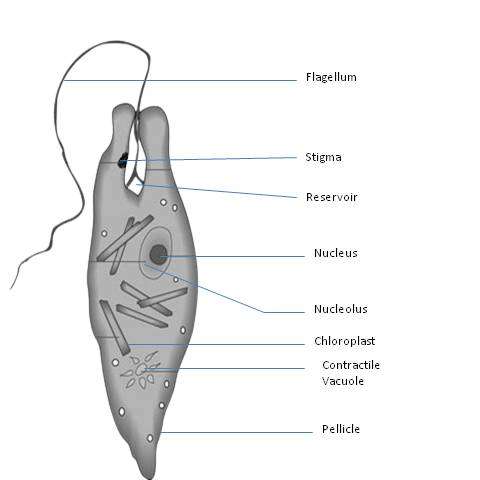In this article about Euglena, we will learn the structure of Euglena viridis.
Systematic Position of Euglena
| Domain: | Eukaryota |
| Kingdom: | Protista |
| Phylum: | Euglenozoa |
| Subphylum: | Sarcomastigophora |
| Class: | Euglenoidea |
| Order: | Euglenida |
| Family: | Euglenaceae |
| Genus: | Euglena |
Diagram of Euglena

Fig: Structure of Euglena
Structure of Euglena
Euglena is a protozoan that is a solitary and free-living freshwater flagellate. It is autotrophic in sunlight but becomes heterotrophic in dark. It can perform photosynthesis to produce its own food with the help of chloroplasts and sunlight. It can also take food when it is in the dark. The structure of Euglena is described below.
Shape, Size, and Color
- It is a tiny microscopic organism.
- It measures about 60 microns in length.
- Body elongated.
- Spindle-shaped body.
- The anterior part of the Euglena is rounded, the middle part is somewhat broader and the posterior part is pointed.
Pellicle
- The body of Euglena is enveloped by the pellicle.
- It is thin, elastic, and tough.
- It lies beneath the plasma membrane.
- It is flexible enough and it permits movements.
- It is made of protein. That’s why it is different than the plant cell wall because the plant cell wall is made of cellulose.
- Muciferous bodies and microtubules are present beneath the pellicle.
Cytoplasm
- The cytoplasm is enclosed by the pellicle.
- The cytoplasm is divided into two zones.
A. Ectoplasm
- It is the peripheral zone of the cytoplasm.
- It is clear, dense, and narrow.
- It contains microtubules and muciferous bodies.
B. Endoplasm
- It is the central zone of the cytoplasm.
- It is more fluid-like and granular than the ectoplasm.
- It contains the nucleus.
Reservoir
- A permanent flask-shaped cavity located at the anterior end of the body is known as the reservoir.
- It consists of a wide reservoir or flagellar sac which leads through a short tubular canal, the cell gullet or cytopharynx, to the outside.
- The external opening of the reservoir is called the cell mouth or cytostome.
- The reservoir is lined by the plasma membrane without the pellicle beneath it.
Flagellum
- It is present at the anterior end of the body.
- It is a single thread-like and arises through the cytostome.
- It is the main locomotor organ of the Euglena.
- It is seen moving while the Euglena is progressing forward.
Nucleus
- A single, large, spherical, or oval-shaped nucleus is present in the Euglena.
- It lies near the center of the endoplasm and near the posterior end of the body.
- It consists of nuclear membrane, nucleolus, nucleoplasm, and chromosomes.
- A large solid central body or nucleolus of chromatin, called endosome or karyosome is present.
- The nuclear membrane is a double membrane which is perforated by pores.
Contractile Apparatus
- It is a dense osmoregulatory zone associated with the reservoir.
- It has a large central contractile vacuole and is surrounded by several smaller accessory vacuoles.
- It plays a role in the discharge of water along with some waste products of metabolism through the reservoir, cytopharynx, and cytostome.
Stigma
- It is a red pigment spot that lies near the reservoir and opposite side of the contractile vacuole.
- It is cup-shaped and also called as eye-spot.
- It forms a photoreceptor apparatus by which the Euglena can detect light.
- Euglena moves towards the sunlight with the help of the stigma.
Endoplasmic Inclusions
Besides contractile apparatus and stigma, the endoplasm has other important inclusions which are also a part of the structure of Euglena and they are as follows-
A. Chromatophores or chloroplasts
- They are the green bodies in the cytoplasm.
- They give the Euglena green color because they contain green pigments.
- They contain chlorophyll a, chlorophyll b, and β-carotene.
- Euglena can produce its own food by performing photosynthesis with the help of these chloroplasts and sunlight.
B. Paramylon
- The endoplasm contains paramylon which is a polysaccharide.
- It is oval-shaped, granular and similar to starch.
- It is produced by photosynthesis.
- It is reserved food for Euglena.
C. Other Cytoplasmic Structures
- The cytoplasm contains Golgi bodies which are large flattened sacs with minute vesicles.
- The cytoplasm also contains endoplasmic reticulum which is in the form of small interconnecting tubules and vesicles.
- The cytoplasm also contains mitochondria which are with tubular cristae and occur more in number near the reservoir.
- The cytoplasm also contains ribosomes which occur scattered freely.
———-THE END————
See more:
- Reproduction of Euglena | Binary Fission, Multiple Fission & Encystment | Diagram
- Locomotion (Movement) and Nutrition of Euglena | Diagram
- Encystment of Euglena
- General Characters of All Phylum of The Invertebrates.
Reference:

Md Ekram Hossain Bhuiyan is a passionate student currently pursuing his studies at Jagannath University in Dhaka. He is a zoology major and his love for animals, nature, and wildlife is evident in his academic pursuits. Ekram is a curious and adventurous individual who always seeks to learn more about the world around him. His passion for animals began at a young age, and he has since dedicated himself to studying the behavior, anatomy, and habitats of various species.
He finds peace in being surrounded by the beauty of nature and observing the creatures that call it home. He believes that it is important to protect and preserve the natural world for future generations.
As a student of zoology, Ekram is dedicated to expanding his knowledge of the subject. He is a hardworking individual who strives for excellence in his studies and is always eager to take on new challenges. Ekram is a driven and compassionate individual who is dedicated to his studies and his passion for animals, nature, and wildlife.